Aellopos tantalus, Tantalus sphinx
|
|
Updated as per More, Kitching and Cocucci's Hawkmoths of Argentina 2005, October, 2007
Updated as per All Leps Barcode of Life, October, 2007
Updated as per Fauna Entomologica De Nicarauga, November 2007
Updated as per personal communication with Shelby Heeter, Islamorada, Florida, January 2009
Updated as per CATE Sphingidae (description; Paraguay, Brazil, Chile, Argentina, Bolivia); May 15, 2011
Updated as per personal communication with Sergio D. Rios Diaz in CATOLOGO DE LOS SPHINGIDAE (INSECTA: LEPIDOPTERA) DEPOSITADOS EN
EL MUSEO NACIONAL DE HISTORIA NATURAL DEL PARAGUAY; sent to me in July 2014 by Sergio D. Rios Diaz.
Updated as per personal communication with Ezequiel Bustos (Shilap revta. lepid. 43 (172) diciembre, 2015, 615-631 eISSN 2340-4078 ISSN 0300-5267), January 4, 2016
Updated as per personal communication with Francierlem Oliveira (Extremoz, Rio Grande do Norte, Brazil); May 31, 2016
Updated for Brazil as per Haxaire & Mielke, European Entomologist; October 21, 2019; March 29, 2022
|
Aellopos tantalus tantalus
Linnaeus, 1758
The Tantalus Sphinx
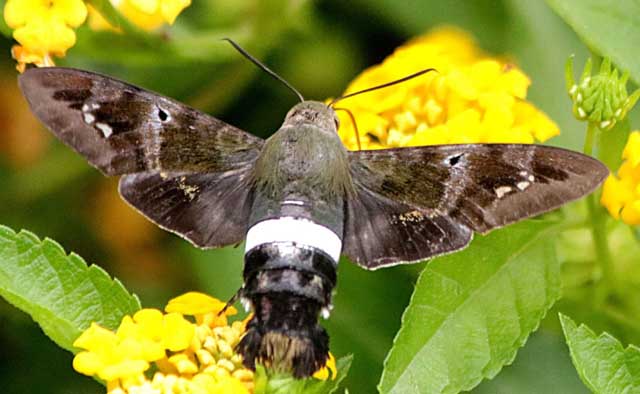
Aellopos tantalus tantalus, Massaranduba, Santa Catarina, Brazil,
January 17, 2021, courtesy of Joao Amarildo Ranguetti.
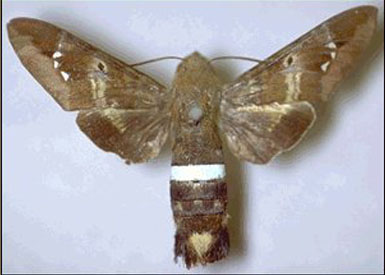
Aellopos tantalus zonata, Florida, courtesy of Paul Opler.
This site has been created by Bill Oehlke.
Comments, suggestions and/or additional information are welcomed by Bill.
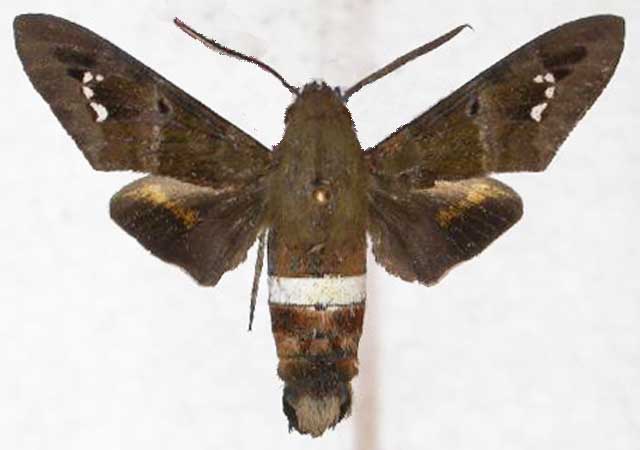
Aellopos tantalus tantalus, 43mm, Concepcion, Paraguay, courtesy of Ulf Eitsberger.
There appears to be very little distinguishing nominate Aellopos tantalus tantalus from
subspecies Aellopos tantalus zonata, but I believe subspecies zonata is limited to Florida and the Caribbean Islands.
TAXONOMY:
Family: Sphingidae, Latreille, 1802
Subfamily: Macroglossinae, Harris, 1839
Tribe: Dilophonotini, Burmeister, 1878
Genus: Aellopos Hubner, [1819] ...........
Species: tantalus Linnaeus, 1758
|
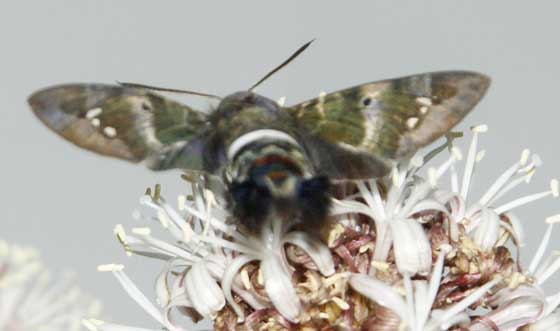
Aellopos tantalus zonata, Islamorada, Monroe County, Florida, December 22, 2008,
courtesy of Kevin and Shelby Heeter, id confirmed by James P. Tuttle.
Islamorada, "Village of Islands" is an incorporated village in Monroe County, Florida, on the islands of Lower Matecumbe Key, Upper Matecumbe Key, Windley Key and
Plantation Key in the Florida Keys.
DISTRIBUTION:
Aellopos tantalus, the Tantalus Sphinx
(wingspan: 1 3/4 - 2 1/4 inches (4.5 - 5.7 cm)),
is found in Tropical America, preferring tropical and subtropical lowlands, but is also found in semi desert places, tropical rainforest and dry forest.
The subspecies A. tantalus zonata (Drury, 1773) occurs in Florida and
in the Caribbean area. A. tantalus zonata has been reared on Randia aculeata and Casasia clusiifolia.
The moth is on the wing during the day, and it
has been reported in
Mexico as subspecies zonata;
Nicaragua: Matagalpa;
Bolivia;
Chile;
Argentina: Buenos Aires, Catamarca,
Chaco, Corrientes, Entre Rios, Formosa, Tucuman, Salta, Misiones;
Brazil: Amazonas; Matto Grosso: Miranda; Rio Grande do Norte: Extremoz (FO?); Santa Catarina (JAO); Rio Grande do Sul;
Paraguay: Asuncion; Concepcion; Central; Palino Cue;
Uruguay;
and the West Indies to Florida. There is at least one record each
from New York and southern Michigan.
There are East Caribbean records (probably subspecies zonata) from
St. Lucia;
Guadeloupe;
Martinique;
St. Martin; St. Bart's;
Dominica; and
Barbados.
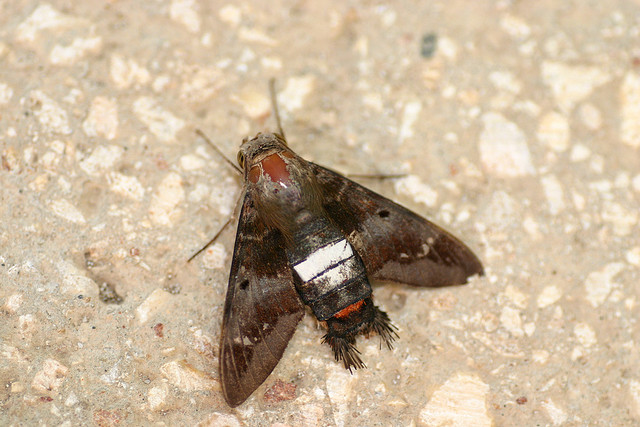
Aellopos tantalus zonata, Dominican Republic,
May 24, 2007, courtesy of Sarah Kickler Kelber
The body is reddish brown with a wide white band across the abdomen segment 4. The forewing upperside is reddish brown
with a black cell spot and three white spots (upper spot largest and often divided) near the gray marginal area.
A paler, almost vestigial median band runs from the cell spot to the inner margin of the wing. The hindwing upperside is dark brown with an indistinct pale
yellow median band on the upper half of wing; no white patch at anal angle.
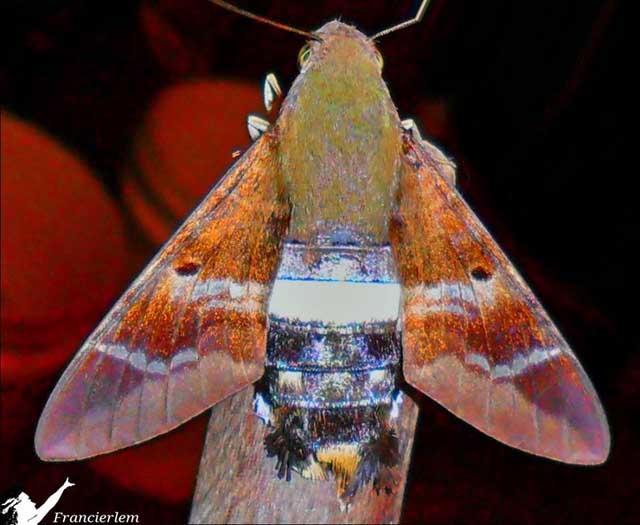
Aellopos titan/tantalus, Extremoz, Rio Grande do Norte, Brazil,
courtesy of Francierlem Oliveira, id by Bill Oehlke.
The image directly above could be either Aellopos titan or Aellopos tantalus. I definitely favour titan, but would want to see the hindwing
anal angle to be more certain.
Synonyms:
Sphinx ixion Linnaeus 1758;
Sphinx zonata Drury 1773; possibly?? now recognized as valid for Florida and the Caribbean
Sphinx terpunctata Goeze 1780;
Macroglossa sisyphus Burmeister 1856.
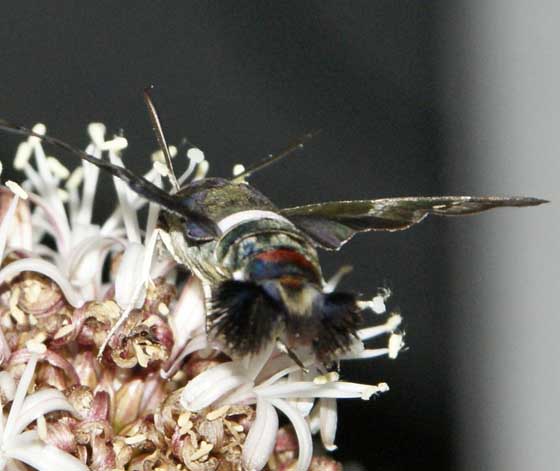
Aellopos tantalus zonata nectaring on Draceana fragrans, Islamorada, Monroe County, Florida, December 22, 2008,
courtesy of Kevin and Shelby Heeter, id confirmed by James P. Tuttle.
FLIGHT TIMES:
This species broods continuously in the tropics and in Florida.
Adults nectar on flowers, including white stopper
(Eugenia axillaris),
corn plant
(Draceana fragrans),
lantana,
flamevine and golden creeper/beach creeper/cough bush
( Ernodea littoralis).
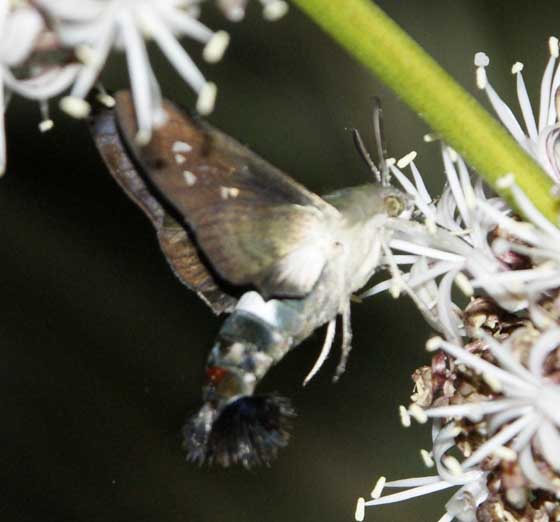
Aellopos tantalus zonata nectaring on Draceana fragrans, Islamorada, Monroe County, Florida, December 22, 2008,
courtesy of Kevin and Shelby Heeter, id confirmed by James P. Tuttle.
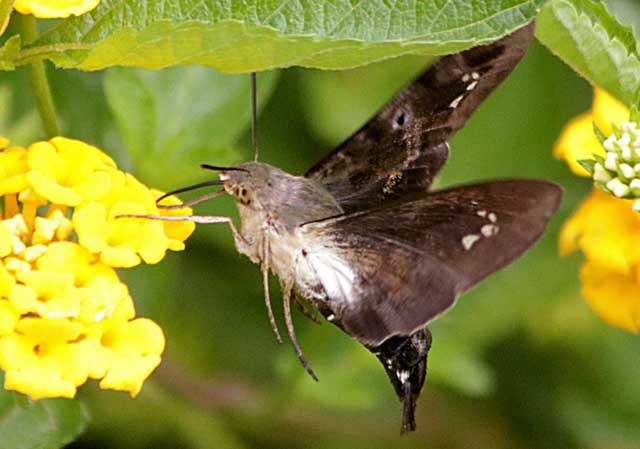
Aellopos tantalus tantalus, Massaranduba, Santa Catarina, Brazil,
January 17, 2021, courtesy of Joao Amarildo Ranguetti.
ECLOSION:
Adults eclose in the morning from pupae formed in cocoons in shallow subterranean
chambers or under leaf litter.
SCENTING AND MATING:
Females call in the males with a pheromone released from a gland at the tip of the abdomen.
EGGS, LARVAE, PUPAE:
Yellow-green, translucent eggs are usually deposited singly on new foliage or buds in the early afternoon.
Within a few days, the deleloping larva can be seen through the eggshell. Newly emerged larvae feed on tender,
new leaves until they have developed a bit.
Larvae feed on seven year apple, Casasia clusiifolia, and
probably other plants in the
madder family. They have been reported on Indigo-berry
(Randia aculeata).
"Host plants: The subspecies A. tantalus zonata (Drury, 1773) which occurs in Florida and
in the Caribbean area has been reared on Randia aculeata and Casasia clusiifolia. There
is a strange record of a full grown larva feeding on Conocarpus erecta (Combretaceae),
amazing family for a genus of Sphingidae that seems to be strictly subservient to the
Rubiaceae family (Tuttle 2007). The larva of the nominative subspecies is unknown." Haxaire and Mielke
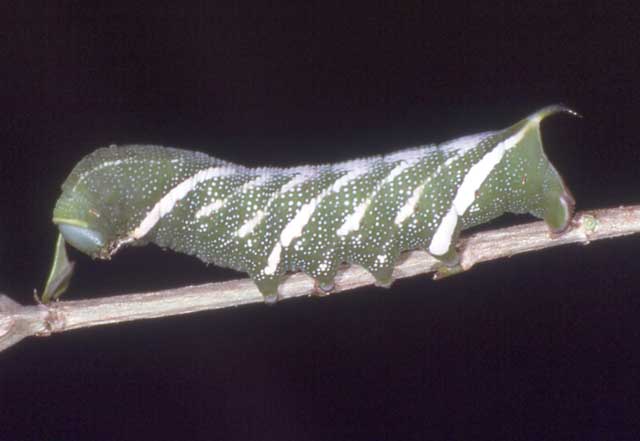
Aellopos tantalus zonata fifth instar, North Key Largo, Monroe County, Florida,
copyright/courtesy of James P. Tuttle.
Caterpillars pupate in loose cocoons in shallow underground chambers or in leaf litter. Pupae are dark, smooth and shiny, and
relatively thin considering the stout appearance of the moth.
Return to U. S. A. Table
Return to Sphingidae Index
Return to Dilophonotini Tribe
Use your browser "Back" button to return to the previous page.
This page is brought to you by Bill Oehlke and the
WLSS. Pages are on space rented from Bizland. If you would like
to become a "Patron of the Sphingidae Site", contact Bill.
Please send sightings/images to Bill. I will do my best to respond to
requests for identification help.
Enjoy some of nature's wonderments: Saturniidae cocoons.
Cocoons of the giant silkmoths may be purchased in the fall and winter. Big and beautiful giant silk moths will emerge in spring/summer.
Read Actias luna rearing article. Additional online help available.









